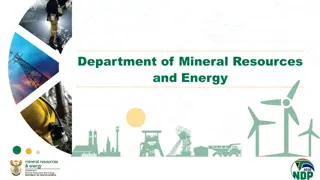Economy of Southwest Asia: Oil, OPEC, and Cultural Influences
Oil discovery in Southwest Asia transformed the region's economy, with OPEC playing a key role in pricing. Primary products like oil and secondary goods influence the economy. Islam shapes the culture, while debates on Westernization persist.
Download Presentation

Please find below an Image/Link to download the presentation.
The content on the website is provided AS IS for your information and personal use only. It may not be sold, licensed, or shared on other websites without obtaining consent from the author. Download presentation by click this link. If you encounter any issues during the download, it is possible that the publisher has removed the file from their server.
E N D
Presentation Transcript
Economy of Southwest Asia Oil was discovered in Iran in 1908. It is now the most important product in the region s economy. Nearly half of the world s oil is in Saudi Arabia, Iran, Kuwait, and Iraq. Saudi Arabia is the world s largest producer and one of the largest exporters to the U.S. Most are nationalized or government run.
Oil In 1960, many of the oil producing nations (Iran, Iraq, Saudi Arabia, Kuwait, and Venezuela) agreed to form a cartel. A cartel is an international organization formed to regulate prices and production. The cartel, called OPEC (Organization of Petroleum Exporting Countries) placed an embargo on exporting oil to countries that supported Israel which increased prices by 70% in 1973. American gasoline prices more than doubled and people waited for gasoline in lines sometimes over a mile long. Oil remains crucial to the entire developed world. This fact gives OPEC nations enormous power. Oil has changed the Middle East and North Africa. Many leaders in the region have used the wealth from oil to modernize their nations, while others kept the wealth or used it to buy weapons and build armies. Petroleum is a non- renewable resource, so oil-producing nations must prepare for a time when their petroleum wealth no longer exists. Experts believe that the price of oil will continue to rise as supplies are used up in easily accessible areas. The world will likely prepare for the exhaustion of petroleum reserves by switching to other sources of energy.
Primary Products (raw materials) Most important in the region is oil (petroleum) Most exports of the region are primary products Other primary products include cotton, fish, natural gas, and coal
Secondary Products (goods manufactured from primary products) Goods from date palms include syrup paper from palm leaves Petrochemicals from oil and natural gas are used in Cosmetics Plastics Detergents fertilizers
Religion in the Region Islam is the major religion in the region and therefore exerts a tremendous influence upon the culture of the region Islam s influence on the culture of the region includes: People stop to pray five times a day Many travel to Mecca on a hajj During Ramadan they fast from sunrise to sunset. This causes economic activity to drop because it s hard to work when you re hungry. Different calendar 12 months of 29 days (each year is 11 days shorter than western calendar) Days start at sunset
Westernization vs. Traditional Culture Some feel that there is too much western influence over traditional Islamic culture Some feel westernization provides a higher standard of living and an easier lifestyle and thus welcome fast-food restaurants, T-shirts, television, rap music, and technology
Roles of Women Different in different countries of the region Israel, Jordan, Egypt Well educated Hold important positions in business, politics, military Iran and Afganhistan fewer rights than men must be with a man at gatherings forbidden to drive cars one husband while men can have up to 4 wives few work outside the home saudi_women Saudi Arabia: Sex- segregated sidewalks
Clothing and Culture Israel some wear western fashions Orthodox women dress modestly; men wear black suits, hats, and long ringlets of hair in front of their ears Islamic countries Iran and Saudi Arabia require women to wear chadors covering their hair. Men dress and grow facial hair according to Islamic law men Jordan Turkey and Egypt allow women to wear what they choose
Quiz-True or False 1. All of the world s oil is found in Southwest Asia and north Africa. 2. Saudi Arabia is the world s largest oil- producing country. 3. OPEC was formed by four countries in Southwest Asia. 4. OPEC is powerful because the world is dependent on oil. 5. Oil is the most important secondary product in Southwest Asia and North Africa.
Quiz continued 6. The dominant religion in Southwest Asia and North Africa is Islam. 7. Muslims fast during Ramadan. 8. All people in Southwest Asia and North Africa welcome westernization. 9. Women in Iran have equal rights with men. 10. Many Islamic countries still require women to wear chadors.























